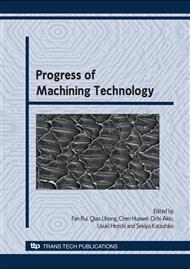p.494
p.500
p.504
p.509
p.516
p.521
p.528
p.533
p.538
Statistical Research on the Effects of Cutting Edge Preparation on Face Milling of Austenitic Stainless Steel Using FEM
Abstract:
Austenitic stainless steels are extensively used in the areas with high corrosion. The high heat resistance and strength make them difficult-to-cut materials. The tool life in machining austenitic stainless steels is restricted by the high cutting force and temperature which induce the tool wear and edge chipped. To achieve tool edge strength and reduce the edge-related problems, tool edge preparation is applied by introducing the chamfered and honed edges. In the current paper, the effects of the cutting edge preparation in face milling of austenitic stainless steels were studied using statistical method. The output cutting parameters as cutting force, temperature were obtained by finite element analysis. The purpose for this research is to give guidance to the tool edge preparation for machining stainless steels.
Info:
Periodical:
Pages:
516-520
Citation:
Online since:
February 2009
Authors:
Price:
Сopyright:
© 2009 Trans Tech Publications Ltd. All Rights Reserved
Share:
Citation:


